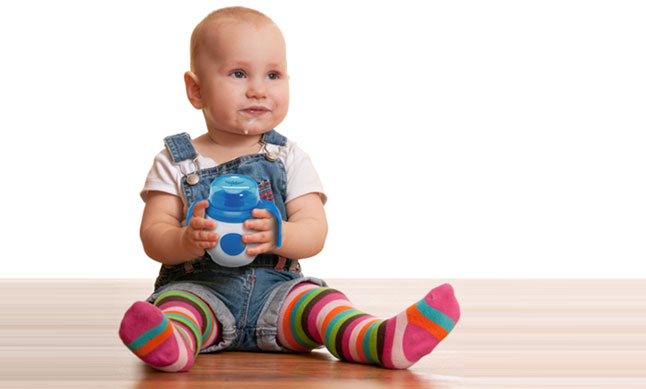The time leading up to your little one’s first birthday is so exciting! Daily changes and development are peppered with major milestones that keep life interesting (to say the least). One of the many important milestones during this time is the transition from breastmilk or formula to whole milk. As a pediatric dietitian, parents often ask me how to make this transition and why it is so important to wait until their child’s first birthday to make the big switch. These are both great, and important, questions.
Full fat cow’s milk, or whole milk, can offer many important nutrients and vitamins for growing toddlers. It contains potassium, calcium, vitamin A, protein, carbohydrates and fat. Plus, almost all milk is fortified with vitamin D. These nutrients and vitamins can help build your toddler’s bones and teeth, regulate body functions and muscle development. And the fat in whole milk is important for young toddlers brain development.
Although these are great reasons to offer whole milk to toddlers, they are not so great for babies. Infants do not digest cow’s milk very well, and some nutrients in cow’s milk, like potassium, protein, chloride and sodium, can be harmful to an infant’s kidneys because of the amounts that whole milk contains. So it is best to offer breastmilk or formula until their first birthday, in order to make sure that they are getting all of the important nutrients that their growing bodies need.
A few approaches to transition your toddler:
- Go cold turkey — Some toddlers respond well to the switch. Often, it just depends on how they react to change. If your little one is relatively adaptable, then you can simply pick a day after their first birthday and offer milk in their cup or bottle instead of breastmilk or formula.
- Alternate each feeding — Another way to introduce whole milk is to offer a couple of servings of the breastmilk or formula that your toddler is used to throughout the day, and offer a couple of servings of whole milk in between. If this appears to work better for your toddler, try this for a week or two and then slowly begin replacing breastmilk or formula servings with whole milk.
- Mix them up — If your toddler has a really hard time with change, then this may be the best route to take. Try mixing the breastmilk or formula with whole milk for a gradual change. Mix 1 part whole milk to 3 parts breastmilk or formula. Gradually increase the amount of whole milk while decreasing the amount of breastmilk or formula over the course of several weeks until your little one is comfortable with the change.
There really is not a right or wrong way to transition to whole milk — it just depends on what works best for you and your toddler. Also, breastfeeding moms may prefer to continue offering breastmilk instead of transitioning to whole milk right away. That’s totally okay! Breastmilk is still extremely nutritious and continues to offer a number of beneficial nutrients and vitamins.
Tips for the big switch:
When you make the change, here are a few more tips to consider that may help to make the transition a smooth one.
- Use a new, special cup for the whole milk.
- Try warming the whole milk, just as you would have for breastmilk or formula.
- Aim for 16 to 24 ounces of whole milk per day (which is about 2 to 3 cups per day). Any more than that could cause your child to lose out on other important nutrients from other foods like fruits, vegetables, whole grains and meats.
- Watch for any signs of milk intolerance or allergic reactions. Symptoms may include diarrhea, skin rash, vomiting, abdominal pain and difficulty breathing. If any of these signs occur, contact your child’s health care provider immediately.
- Once your toddler turns 2, you can then transition them to a lower fat milk, like 1%. After 24 months, your little one does not need the higher fat content as they did before.
